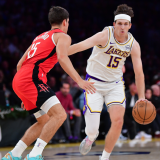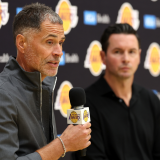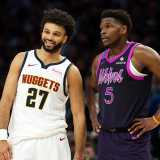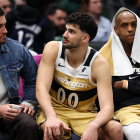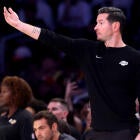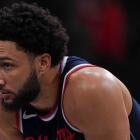In wake of Durant to Warriors, Adam Silver vows to fix broken NBA labor deal
Some modest tweaks could ease the pain of a star like Kevin Durant leaving his team

They say it's so hot in Las Vegas you could fry an egg on the pavement outside the Thomas & Mack Center, where the NBA is holding its annual Summer League.
For the record, that's not true; our brains fried from too much basketball, intrepid NBA communications guru Joanna Shapiro and I tried that a couple of summers ago. It didn't work.
Nonetheless, the egg on commissioner Adam Silver's face Tuesday at his post-Board of Governors news conference was practically sizzling. The smoke is still billowing from the five-alarm fire that was this free-agent summer -- a frenzy of player movement that could affect the competitive balance of the league for years to come.
The topic du jour, of course, was Kevin Durant, who left Oklahoma City after nine years with the little franchise that could and joined forces with three All-Stars -- including the two-time reigning MVP -- in the Bay Area. As Silver dusted off his talking points from the 2011 lockout, it reinforced the notion -- often lost in documenting Durant's decision for posterity -- that this is something that wasn't supposed to be allowed.
There they were again from Silver on Tuesday, the two goals that would never change: 1) NBA franchises, if well managed, should have a chance to be profitable; and 2) regardless of market size or the depth of ownership's pockets, they should have the opportunity to compete for championships.
As the league forged ahead with a massive reduction in the players' share of revenue and onerous system restrictions designed to rein in the big-spending teams in glamour markets, the system was working for a while. Oklahoma City, albeit hamstrung by the escalated luxury-tax system and forced to trade James Harden in 2012, had persevered and become the beacon of small-market success that Silver had envisioned at the bargaining table six years ago.
An unanticipated tripling of the league's broadcast deals -- "We did not model for such a large spike," Silver said Tuesday -- threw all of those plans under a freight train this month. The massive jump in the cap from $70 million to $94 million -- plus, the Warriors' good fortune at having MVP Stephen Curry on a wildly below-market deal, and other factors -- paved the way for the kind of star-clustering that the CBA was supposed to prevent.
"I don't think it's good for the league, just to be really clear," Silver said. "I will say whoever is the prohibitive favorite, try telling that to the 430 other players who aren't on those two teams. I mean, we have the greatest collection of basketball players in the world in our league, and so I'm not making any predictions, but there's no question, when you aggregate a group of great players, they have a better chance of winning than many other teams."
At the league meetings in Las Vegas, the Durant decision was front-and-center in dialogue among owners and executives in the context of what can be done to recalibrate the deal with the National Basketball Players Association.
"Of course we discussed the activities from the last two weeks for free agency," Silver said. "I would say we had a robust discussion in the room of various views of player movement that we've seen."
For several months, the league and union have been meeting to pave the runway for a new labor deal. As CBS Sports first reported in December, the goal of the discussions isn't simply for one side or the other to decide whether to exercise its right to opt out of the deal by Dec. 15. The purpose is to agree on a completely new labor deal before this two-year cap spike does any more damage.
"I think we do need to re-examine some of the elements of our system so that I'm not here next year or the year after again talking about anomalies," Silver said. "There are certain things, corrections we believe we can make in the system. Of course we're not going to negotiate here with the union; it requires two parties to make those changes. I think we've had very productive discussions with the union so far, and we will continue to do so."
There are two obvious ways to tackle the problem, and they're both non-starters for one side or the other.
First, there are renewed signs that hard-line owners are digging in with the intention of achieving the league's long-sought goal of a hard salary cap. It was the biggest bargaining chip that Silver, as the NBA's lead negotiator during the last round of labor talks, had to leave on the table to get a deal done that saved the 2011-12 season.
The union will never go for it. In 2011, former executive director Billy Hunter's position was that the only way he'd agree to a hard cap was if it were set impossibly high so it almost wouldn't matter. It's laughable to think that his successor, Michelle Roberts, would surrender such sacred bargaining territory in her first CBA rodeo.
Second, the league could push to remove the cap on individual player salaries, i.e. "the max," a concept that has been corrupted over the years to include any and every remotely desirable free agent. It's how Mike Conley agreed to the richest contract in league history this month; five years, $153 million.
Such a change would make Durant, Curry and LeBron James very happy, because their earning power would be limited only by the amount of cap room a team was able to carve out. It would please small- and mid-market owners, too, because it would be effectively impossible for Durant and Curry to play on the same team. But it would not be palatable to the other 99 percent of the union membership, whose bank accounts would be raided to pay a few superstars. Another non-starter.
Putting a mechanism in the cap that would account for unexpected revenue spikes and ease them into the system would be a good place to start. But the NBPA rejected the league's smoothing proposal this time around. Silver said Tuesday the league's broadcast partners wouldn't go for that, either.
There's the NFL's franchise tag, but even Silver seems to have given up on emulating the league with the oddly shaped ball, saying at All-Star weekend, "We're never going to have NFL-style parity in this league."
There are a couple of more modest adjustments that could help limit the disruptions that occur when star players leave their teams. They both involve the rules about veteran extensions.
In the current deal, virtually all incentives for veteran players to agree to contract extensions prior to hitting free agency were removed. Currently, veteran extensions -- i.e., those that are not extensions of rookie-scale contracts -- are limited to four seasons including those remaining on the current deal. It's why Chris Paul didn't sign an extension with the Clippers, instead opting to hit free agency and get a longer deal.
It's also why Durant never once considered signing an extension with the Thunder prior to becoming a free agent.
The rules for veteran extensions are even more onerous when it comes to extend-and-trades, which are now virtually non-existent. This is the kind of arrangement that allowed Carmelo Anthony to get a max extension as part of a trade from Denver to the Knicks in 2011 -- thereby allowing the Nuggets to receive players and draft picks for their departing star, as opposed to the zero, zippo, nada that the Thunder got for Durant.
Here's how relaxing some of these restrictions could be beneficial.
Let's say the Thunder get into the 2016-17 season and Russell Westbrook decides he doesn't like playing there without Durant. Westbrook will be a free agent in July, and the Thunder fear they're going to lose him, too.
With the current rules, it would be exceedingly difficult for the Thunder to trade Westbrook at the February deadline. Extensions agreed to as part of a trade are limited to three years and subject to 4.5 percent annual increases (as opposed to the 7.5 percent that players get when they sign with their current teams). Furthermore, the Thunder wouldn't be permitted to do an extend-and-trade with Westbrook since such transactions are forbidden in the last year of a player's contract (or when the player is approaching an option year, as Westbrook will be).
Any team wanting to acquire Westbrook in a trade would be faced with the substantial risk that he could leave as free agent only months later.
Wouldn't it be better for a Westbrook suitor -- say, the Celtics -- to have certainty in the form of an extension so the asset equation in the trade were clear? And even more critically, wouldn't it be better for the Thunder, if faced with the excruciating possibility of losing another top-five player to free agency, to be able to acquire players and draft picks to soften the blow?
It certainly would help.
"My sense is that some of the player movement we just saw is not necessarily a function of market size," Silver said. "It's clearly, in the case of one particular player, a desire to be in a situation with a group of players who have already proven that they can win. And by the way, I don't mean to be so cryptic; in the case of Kevin Durant, I absolutely respect his decision, once he becomes a free agent, to make a choice that's available to him. In this case he operated 100 percent within the way of the system, and same with Golden State."
Which is why Silver knows that the loopholes in the system that allowed it are 100 percent in need of fixing.



